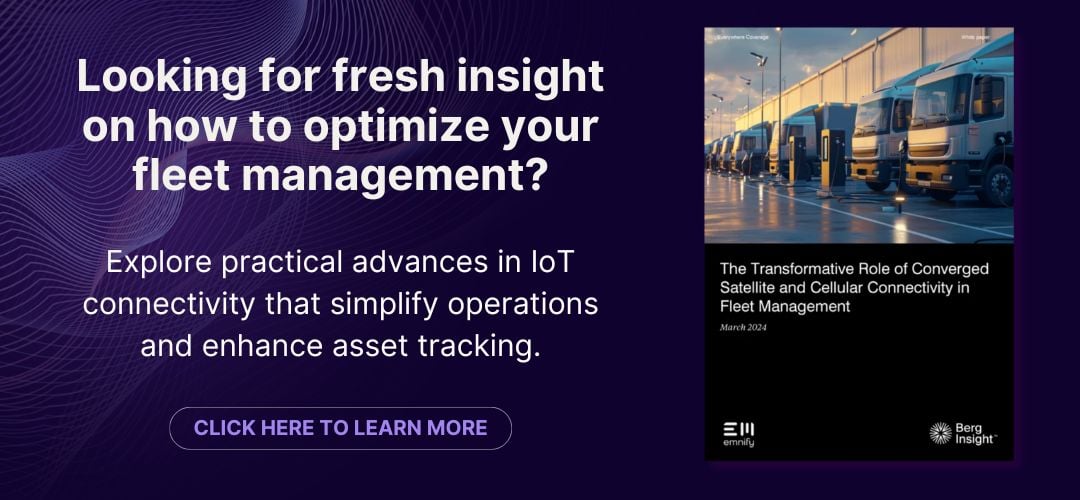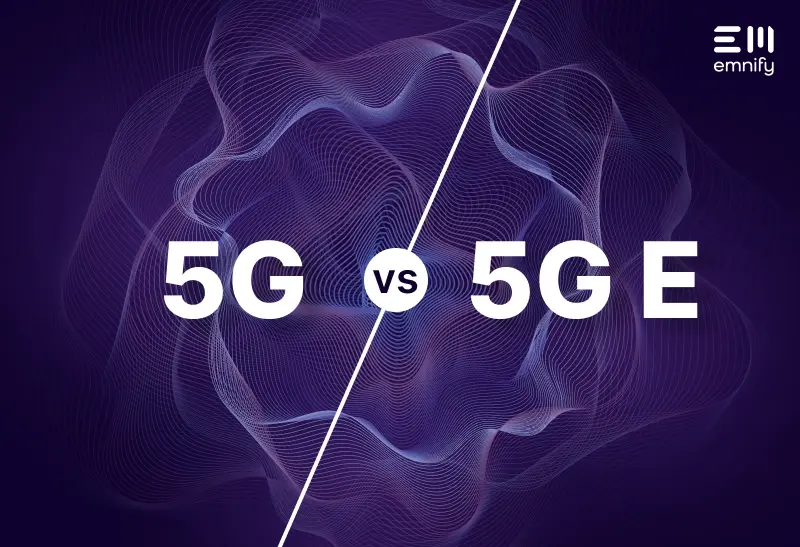

If you are a fleet manager, reliable connectivity to your IoT devices is critical to the efficiency of your operations. You depend on cellular and satellite networks to ensure you can monitor and communicate with your fleet in real time.
If your IoT fleet systems lose connectivity to GPS trackers, dash cameras, and other telematics devices, you lose visibility and control of your vehicles and valuable assets. The better your network connectivity, the better your fleet management system can help you monitor your vehicles, containers, and cargo.
This issue quickly becomes daunting if your fleet operations expand across regions and traverse international borders. Typically, fleet systems lose connectivity when a vehicle or other asset travel’s out of a network's reach (often simply by moving between urban and rural areas). Alternatively, coordinating service from multiple network providers is complex, time consuming, and expensive.
But there are emerging connectivity options for fleet managers. A new generation of IoT networks provide seamless connectivity to fleets and assets on the move, no matter where they go. These virtualized, cloud-based communications platforms provide far greater flexibility and reliability compared to traditional connectivity options while significantly simplifying management and lowering operational costs.
10 ways modern IoT networks make fleet management easier
1. Seamless cross-border and international communications
The new generation of IoT connectivity platforms can span regions and international borders, seamlessly connecting with local cellular networks for redundancy as vehicles cross geographies. And if fleet vehicles and cargo travel outside of cellular range, fleet management devices can easily stay connected with satellite services.
For example, seamless international connectivity could greatly benefit any trucking fleet that travels across the US and into Canada or Mexico. The automated network handoff reduces management headaches and costs while ensuring fleet management systems don’t go dark after crossing borders.
2. Better cost control
By being able to collect unified and comprehensive data on vehicle travel, driver activities, cargo deliveries, fuel consumption, and maintenance costs, fleet managers can see trends and recognize areas for cost saving. With the right connectivity, managers can avoid having “blind spots” into what’s happening in the field.
For example, you can accurately compare the relative costs of operating trucks in the US, Canada, and Mexico, helping your organization more profitably bid on work for deliveries into those neighboring regions.
3. Improved asset tracking
Regardless of where your vehicles, equipment or cargo travel, a modern, global IoT connectivity network ensures you can find your assets, no matter where they are.
With comprehensive cellular and satellite coverage, vehicles and assets are always in view.
For example, even if your vehicles cross borders or move out of cellular range, you can see any unscheduled stops for a delivery truck in real time.
4. Increased driver productivity
Drivers and vehicles can be more easily managed with a continuous feed of data on vehicle location, progress on routes, and traffic conditions. With real-time updates, fleet managers immediately know where vehicles and drivers are located, making it much easier to assign the right drivers to the right routes at the right time.
By always knowing the location of your vehicles, you can adjust routes on the fly, depending on delivery needs and driver availability. For example, if a driver becomes ill and has to cancel their routes for the day, you can quickly schedule other active drivers to pick up their cargo and complete the deliveries without significant delays.
5. Reduced management complexity
A modern IoT network eliminates the traditional challenges of fleet connectivity. By using the cloud to provide a centralized management platform and virtualizing network services, you can focus on running efficient operations rather than maintaining device connectivity.
Such centralized virtualization greatly reduces the burdens of sourcing and managing services contracts with multiple carriers or setting up services in foreign countries. Additionally, you can avoid the complexities of ensuring all your devices are updated with the necessary SIM cards for each network.
6. Improved safety
By having a reliable network with adequate bandwidth that keeps vehicles continuously connected, you can use cameras and sensors combined with AI to track driver behavior in real time. You can also set up alerts for inappropriate or dangerous driver behavior.
Bonus benefit: potentially lower insurance premiums.
For example, by having real-time reports on vehicles, you can be alerted to any abnormal speeds for the road conditions, either too slow (falling asleep?) or too fast (speeding), helping managers intervene to prevent potential accidents.
7. More dependable vehicles
Reliable, unified network connectivity with responsive APIs makes it possible for you to use sensors and other telematics devices to feed vehicle data into maintenance systems in real time, helping detect operational issues before they become major concerns. Road hours and miles logged are easily tracked to trigger automated notices for timely maintenance.
With the necessary IoT data from vehicles, you can use AI to schedule predictive maintenance for your delivery trucks before they break down and disrupt route scheduling, helping maintain customer service and avoiding additional management complexities.
8. Stronger security
Wireless networks specifically designed for IoT fleet management offer stronger security for the unique challenges of IoT systems, allowing you to more easily block access to non-authorized domains, detect usage anomalies in real time, enforce private connections between mobile networks and the cloud, and safeguard your SIMs from unauthorized use.
For example, you can prevent cache poisoning by selecting the trusted DNS service that provides the availability you need. With a modern IoT connectivity platform, you can configure and utilize your cloud provider's private DNS service that isn’t accessible over the public Internet, so only devices within your virtual private cloud (VPC) can query for your domain.
9. Easier regulatory compliance
When Wi-Fi connectivity isn’t predictable, a modern fleet management network with cellular and satellite connectivity ensures drivers have uninterrupted access to electronic logging devices (ELDs) to comply with US and Canadian regulations.
If you are a fleet manager in the US, you don’t have to worry about additional operational complexities to keep your fleet drivers compliant if they need to cross into Canada. This avoids the patchwork reporting that creates compliance gaps and the potential for regulatory fines.
10. More dependable devices
Real-time network data and full visibility provides clear insights into all your fleet management devices, helping you know exactly how they are performing. Easily keep devices running at their best with over-the-air (OTA) firmware updates and remote SIM provisioning (RSP). As technology evolves, your fleet management system is never out of date.
For example, you will be able to know right away if certain devices are having connectivity issues. And you can troubleshoot and update the software from a centralized management platform. Afterwards, you can easily monitor the devices to ensure the issue was addressed fully.
Network connectivity: The foundation to better Fleet Management
Your IoT fleet management devices are only as good as your network. If devices are not reliably connected, you will lack essential control and visibility of your fleet, equipment, and assets.
Ensure your organization is ready for the next era of fleet management with a modern, cloud-native IoT network that keeps your devices connected, no matter where they roam.
emnify: A new approach to IoT connectivity for Fleet Management
emnify’s IoT SuperNetwork provides the industry’s most comprehensive global coverage and industry-leading uptime with access to 540+ cellular and satellite networks, all from a single SIM.
emnify helps you always stay connected to your vehicles, so you can control costs, reduce complexities, and improve the efficiencies of your fleet operations.
“The best thing that any technology could do is be dependable and simplify things. emnify does just that,” says Todd Morris, CEO of Brickhouse Security, a provider of fleet management and security IoT systems. “Our favorite benefit from emnify is how well we are sleeping at night. With emnify, we don’t have to worry about our network connectivity anymore.”
Learn more about how emnify can provide reliable, real-time IoT connectivity for all your local, regional, and international fleet management needs.
Read how Y.Share used emnify to help fleet operators save 9.5 million liters of fuel.
Tell us about your challenges. We are here to help.

Charles Waltner
Charles Waltner is a former business journalist turned technology executive. He has deep experience in the communications, networking, and IoT markets.




